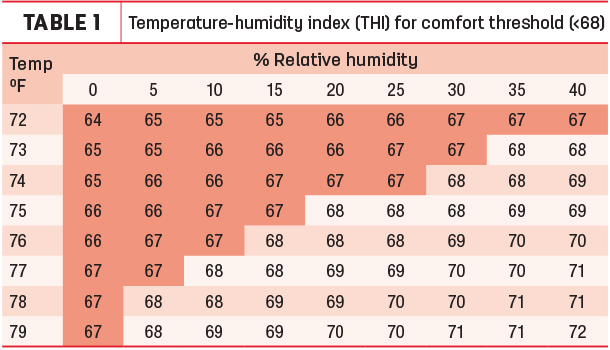Monitoring U.S. average bulk tank somatic cell counts (SCC) over many years shows a clear peak during summer months. Higher temperatures and humidity levels during the June-September period create heat stress in cows and negatively affect their immune response.
The higher temperatures and humidity levels also make it easier for mastitis-causing organisms – particularly those known as environmentals – to survive and grow in organic materials.
Beating the odds during this challenging time of the year requires understanding this dual effect on the cows and the environment, leading to practical ways to mitigate the impact on milk production and udder health. In the end, the goal is always milking dry and clean teats of comfortable cows.
Heat stress occurs when the thermal energy balance existing between the cow and its environment is disrupted. Naturally, the cow will try to regain that balance by reducing dry matter intake and elevating respiration and sweating rates, for starters.
Coping with that temperature change will affect cow health, production and reproductive performance. This imbalance may lead to higher udder infection rates and therefore increased cell counts. Known management practices and the following tips can aid your herd in adjusting to that change.
1. Monitor the cows’ environment, specifically temperature and humidity
Cows are more comfortable in a cool environment. Heat stress occurs when the temperature-humidity index (THI) surpasses 68; this is when you’ll see mild to moderate heat stress. Make sure you monitor both temperature and relative humidity and adjust management protocols to keep cows under comfortable conditions. Table 1 shows the threshold limits and relationship between them.

When cows are feeling heat stress, they will naturally try to cool themselves by lying down in wet areas, standing in cooling ponds (where available) or standing in shade. This may expose them to areas where bacteria are highly prevalent and increase their chances of infections leading to higher cell counts.
Under hot and humid conditions, cows also spend more time drinking water. In an effort to decrease heat production, they will also consume less feed, leading to a drop in milk production. Fifteen to 35 percent milk drops are not uncommon, depending on the lactation stage of the cow.
2. Establish or review heat abatement protocols
Proven ways to keep cows cool during the summer include using water and forced ventilation (fans), air conditioning, foggers, misters and sprinklers. There are specific recommendations regarding when and for how long sprinklers should be turned on, where they should be located and how large the water droplet size should be.
Sprinkling systems are most commonly used to reduce heat, but they are also known to generate about ten times the water volume of misting systems. In the end, the adjusted settings should also take into account cow density to get the desired benefit. When conditions are adequate for cows, they will continue to follow their regular routine and milk production drops can be reduced or eliminated.
3. Make clean drinking water available at all times
Water makes up around 85 to 90 percent of milk. While a cow producing 80 pounds per day may drink 25 gallons of water per day in February, her water needs will increase to 29 gallons per day in August. To meet those needs, plan on making up to 20 percent more drinking water available during the hot summer months.
It is important to know that chilled water does not provide any additional benefit, while water above 86ºF may reduce consumption.
4. Keep bedding clean and dry at all times
Bedding material should primarily provide cow comfort, but you should also consider udder health and cow cleanliness when selecting bedding. Sand is normally the preferred bedding material. It remains cooler than dried manure bedding at all levels of cooling, regardless if sprinklers are turned on or off. Monitor bedding material to confirm expected organic material levels and adjust as necessary.
In warmer months, temperature and humidity and the right levels of organic material provide the right conditions for bacteria to survive and multiply. A heat-stressed cow will be more susceptible to bacterial infection when lying down in poorly managed bedding material.
It is well-known that gram-negative-bacteria-caused mastitis is greater in organic bedding materials (including recycled manure solids), corresponding to short duration infections but high SCC responses. However, gram-positive bacteria seem to be higher in recycled sand bedding and resulting subclinical mastitis cases will be of longer duration, also affecting bulk tank cell counts.
5. Keep teat ends protected from mastitis bugs
For mastitis to occur, bacteria must enter through the teat canal and be able to survive the defense mechanisms of the cow to colonize and grow. Environmental mastitis pathogens are of particular concern in modern dairies that have been able to control contagious organisms reasonably well. These bacteria include gram-positive streptococci (other than strep. agalactiae) such as strep. uberis and strep. dysgalactiae, and enterococcal species such as ent. faecalis and ent. faecium.
Also, gram-negative bacteria such as E. coli, klebsiella spp., enterobacter spp., serratia spp., pseudomonas spp., proteus spp. and citrobacter spp. are very important environmental pathogens that cause intramammary infections, resulting in management headaches for herd managers.
Teat ends open up before milking and close sometime after milking. During this time, udders are at high risk of intramammary infections. One of the best ways to minimize infection risk is doing things right in the parlor. Before milking, use a proven predip together with strict teat cleaning and drying routines.
After milking, consider the use of a proven barrier product which will extend the protection time of the teat ends until the teat canal closes properly. Note that the products used should be able to kill bacteria aforementioned in the time provided (i.e., less than 30 seconds in the predip step).
When using barrier products designed to extend the germicidal activity of the product, confirm not only the broad spectrum germicidal activity of the product used, but also understand the difference between a highly viscous product and a true barrier product. Once dry, a barrier product should leave a stable and flexible film on the teat skin.
Conclusion
Ultimately, the quality of milk (measured by SCC) harvested at milking depends on the level of mastitis infection in the herd. Infection will most likely occur in the cows’ environment, where bacteria have been allowed to prosper beyond defensible levels.
This, combined with an animal that is more susceptible to infection because of the physiological changes caused by heat stress, increases the chances of intramammary infection. You can make a huge difference in cell counts during this time of year by closely monitoring the cows’ environment and employing strict practices that focus on keeping teats clean and disinfected before and after milking. ![]()

-
Mario Lopez
- Technology Manager, Milk Quality and Animal Health
- DeLaval
- Email Mario Lopez








